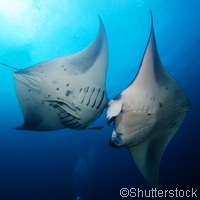Scientists shed light on giant manta ray movements
An international team of researchers provides insight into the movement of the giant manta ray, the world's largest ray measuring up to 25 feet (around 7 metres) in width. Presented in the journal PLoS ONE, the study used satellite telemetry to track the open-ocean journeys of this marine traveller that is listed as 'vulnerable' by the International Union for Conservation of Nature (IUCN). Led by the Wildlife Conservation Society (WCS) in the United States, conservationists attached satellite transmitters to 6 manta rays (4 females, 1 male and 1 juvenile) off the coast of Mexico's Yucatan Peninsula for 13 days. They say manta rays (Manta birostris, or devil fish) are known to be affected by direct and incidental capture, thus affecting their numbers negatively. In their study, they found that satellite-tracked manta rays made short-range shuttling movements, foraging along and between them. 'Almost nothing is known about the movements and ecological needs of the manta ray, one of the ocean's largest and least-known species,' said lead author Dr Rachel Graham, head of WCS's Gulf and Caribbean Sharks and Rays Program. 'Our real-time data illuminate the previously unseen world of this mythic fish and will help to shape management and conservation strategies for this species.' Commenting on the findings, co-author Dr Matthew Witt from the Environment and Sustainability Institute at the University of Exeter in the United Kingdom said: 'The satellite tag data revealed that some of the rays travelled more than 1,100 kilometres during the study period. The rays spent most of their time traversing coastal areas plentiful in zooplankton and fish eggs from spawning events.' Manta rays swim with their mouths open through clouds of plankton. The data show that manta rays spent almost all of their time within the territorial waters of Mexico. However, just a little over 11% of the locations gathered from the tagged rays occurred within marine protected areas (MPAs). The team identified most of the manta ray locations in major shipping routes in the region. Ship strikes could adversely affect manta rays. 'Studies such as this one are critical in developing effective management of manta rays, which appear to be declining worldwide,' said Dr Howard Rosenbaum, director of WCS's Ocean Giant Programme. Despite its devilish look, the manta ray is an innocent creature and poses no danger to people. Unlike the stingray, it does not have a stinger. The researchers say the manta ray has the largest brain to body ratio of all sharks and rays, and gives birth to one to two 'pups' every one or two years. With respect to the study's results, the authors of the study write: 'While the broader migratory movements of manta rays are still not known, it is clear that satellite tracking technology has the potential to offer great inroads into understanding movements and contextualising spatially explicit threats to this species.'For more information, please visit:Wildlife Conservation Society:http://www.wcs.org/PLoS ONE:http://www.plosone.org
Countries
Mexico, United Kingdom, United States



